Experimental Investigation of Stability of Silica Nanoparticles at Reservoir Conditions for Enhanced Oil-Recovery Applications
Abstract
1. Introduction
2. Experimental Materials
2.1. Nanoparticle
2.2. Nanoparticles Suspensions
2.3. Reservoir Rocks
2.4. Oils
3. Experimental Methods
3.1. Nanoparticles Suspension Stability
3.2. Effect of Reservoir Rocks and Crude Oils on Nanoparticle Stability
3.3. Particles Size and pH Measurement of Nanoparticles
3.4. Preparation of Polymer Modified Nanoparticles
4. Results and Discussion
4.1. Nanoparticle Suspension Stability Tests
4.2. Effect of Reservoir Rocks on Nanoparticle Stability
4.3. Effect of Crude Oils on Nanoparticle Stability
5. Conclusions
Author Contributions
Funding
Acknowledgments
Conflicts of Interest
References and Note
- Lau, H.C.; Yu, M.; Nguyen, U.P. Nanotechnology for oilfield applications: Challenges and opportunities. J. Petrol. Sci. Eng. 2017, 157, 1160–1169. [Google Scholar] [CrossRef]
- Kong, X.; Ohadi, M.M. Applications of micro and nano technologies in the oil and gas industry—Overview of the recent progress. In Proceedings of the Abu Dhabi International Petroleum Exhibition and Conference, Abu Dhabi, UAE, 1–4 November 2010. Paper SPE 138241-MS. [Google Scholar]
- Li, S.; Hendraningrat, L.; Torsæter, O. Improved oil recovery by hydrophilic silica nanoparticles suspension: 2-phase flow experimental studies. In Proceedings of the International Petroleum Technology Conference, Beijing, China, 26–28 March 2013. [Google Scholar]
- Hendraningrat, L.; Li, S.; Torsæter, O. A coreflood investigation of nanofluid enhanced oil recovery. J. Petrol. Sci. Eng. 2013, 111, 128–138. [Google Scholar] [CrossRef]
- Joonaki, E.; Ghanaatian, S. The application of nanofluids for enhanced oil recovery: Effects on interfacial tension and coreflooding process. Petrol. Sci. Technol. 2014, 32, 2599–2607. [Google Scholar] [CrossRef]
- Li, S.; Torsaeter, O.; Lau, H.C.; Hadia, N.J.; Stubbs, L.P. The impact of nanoparticle adsorption on transport and wettability alteration in water-wet Berea sandstone: An experimental study. Front. Phys. 2019, 7, 74. [Google Scholar] [CrossRef]
- Wasan, D.T.; Nikolov, A. Spreading of nanofluids on solids. Nature 2003, 423, 156–159. [Google Scholar] [CrossRef] [PubMed]
- Li, S.; Hadia, N.J.; Lau, H.C.; Torsaeter, O.; Stubbs, L.P.; Ng, Q.H. Silica nanoparticles suspension for enhanced oil recovery: Stability behavior and flow visualization. In Proceedings of the SPE Europec featured at the 80th EAGE Conference and Exhibition, Copenhagen, Denmark, 11–14 June 2018. [Google Scholar]
- Hiemenz, P.C.; Dekker, M. Principles of Colloid and Surface Chemistry, 2nd ed.; Dekker: New York, NY, USA, 1986. [Google Scholar]
- Ghadimi, A.; Saidur, R.; Metselaar, H.S.C. A review of nanofluid stability properties and characterization in stationary conditions. Int. J. Heat Mass Transf. 2011, 54, 4051–4068. [Google Scholar] [CrossRef]
- Chang, H.; Wu, Y.C.; Chen, X.Q.; Kao, M.J. Fabrication of Cu based nanofluid with superior dispersion. Natl. Taipei Univ. Technol. J. 2000, 5, 201–208. [Google Scholar]
- Zhu, D.; Li, X.; Wang, N.; Wang, X.; Gao, J.; Li, H. Dispersion behavior and thermal conductivity characteristics of Al2O3–H2O nanofluids. Curr. Appl. Phys. 2009, 9, 131–139. [Google Scholar] [CrossRef]
- Wang, X.; Zhu, D.; Yang, S. Investigation of pH and SDBS on enhancement of thermal conductivity in nanofluids. Chem. Phys. Lett. 2009, 470, 107–111. [Google Scholar] [CrossRef]
- Wei, X.; Zhu, H.; Kong, T.; Wang, L. Synthesis and thermal conductivity of Cu2O nanofluids. Int. J. Heat Mass Transf. 2009, 52, 4371–4374. [Google Scholar] [CrossRef]
- Sofla, S.J.D.; James, L.A.; Zhang, Y. Insight into the stability of hydrophilic silica nanoparticles in seawater for Enhanced oil recovery implications. Fuel 2018, 216, 559–571. [Google Scholar] [CrossRef]
- Hwang, Y.; Lee, J.K.; Lee, C.H.; Jung, Y.M.; Cheong, S.I.; Lee, C.G.; Ku, B.C.; Jang, S.P. Stability and thermal conductivity characteristics of nanofluids. Thermochim. Acta 2007, 455, 70–74. [Google Scholar] [CrossRef]
- Huang, J.; Wang, X.; Long, Q.; Wen, X.; Zhou, Y.; Li, L. Influence of pH on the stability characteristics of nanofluids. In Proceedings of the 2009 Symposium on Photonics and Optoelectronics, Wuhan, China, 14–16 August 2009; pp. 1–4. [Google Scholar]
- Zhu, H.; Lin, Y.; Yin, Y. A novel one-step chemical method for preparation of copper nanofluids. J. Colloid Interface Sci. 2004, 277, 100–103. [Google Scholar] [CrossRef] [PubMed]
- Selvamani, V. Stability studies on nanomaterials used in drugs. In Micro and Nano Technologies, Characterization and Biology of Nanomaterials for Drug Delivery; Mohapatra, S.S., Ranjan, S., Dasgupta, N., Mishra, R.M., Thomas, S., Eds.; Elsevier: Dordrecht, The Netherlands, 2019; pp. 425–444. ISBN 9780128140314. [Google Scholar]
- Ranka, M.; Brown, P.; Hatton, T.A. Responsive stabilization of nanoparticles for extreme salinity and high-temperature reservoir applications. ACS Appl. Mater. Interfaces 2015, 7, 19651–19658. [Google Scholar] [CrossRef] [PubMed]
- Hwang, Y.; Lee, J.; Lee, J.; Jeong, Y.; Cheong, S.; Ahn, Y.; Kim, S.H. Production and dispersion stability of nanoparticles in nanofluids. Powder Technol. 2008, 186, 145–153. [Google Scholar] [CrossRef]
- Zhu, H.; Zhang, C.; Tang, Y.; Wang, J.; Ren, B.; Yin, Y. Preparation and thermal conductivity of suspensions of graphite nanoparticles. Carbon 2007, 45, 226–228. [Google Scholar] [CrossRef]
- Lee, J.; Hwang, K.; Jang, S.; Lee, B.; Kim, J.H.; Choi, S.; Choi, C. Effective viscosities and thermal conductivities of aqueous nanofluids containing low volume concentrations of Al2O3 nanoparticles. Int. J. Heat Mass Transf. 2008, 51, 2651–2656. [Google Scholar] [CrossRef]
- Oh, D.; Jain, A.; Eaton, J.; Goodson, K.; Lee, J. Thermal conductivity measurement and sedimentation detection of aluminum oxide nanofluids by using the 3-omega method. Int. J. Heat Fluid Flow 2008, 29, 1456–1461. [Google Scholar] [CrossRef]
- Oh, D.; Jain, A.; Eaton, J.; Goodson, K.; Lee, J. Thermal conductivity measurement of aluminum oxide nanofluids using the 3-omega method. In Proceedings of the ASME 2006 International Mechanical Engineering Congress and Exposition, Chicago, IL, USA, 5–10 November 2006; pp. 343–349. [Google Scholar]
- Wang, H.; Sen, M. Analysis of the 3-omega method for thermal conductivity measurement. Int. J. Heat Mass Transf. 2009, 52, 2102–2109. [Google Scholar] [CrossRef]
- Metin, C.O.; Lake, L.W.; Nguyen, Q.P. Stability of aqueous silica nanoparticle dispersions. J. Nanopart. Res. 2011, 13, 839–850. [Google Scholar] [CrossRef]
- Hendraningrat, L.; Li, S.; Torsæter, O. Enhancing oil recovery of low-permeability berea sandstone through optimised nanofluids concentration. In Proceedings of the SPE Enhanced Oil Recovery Conference, Kuala Lumpur, Malaysia, 2–4 July 2013. [Google Scholar]
- Khezrnejad, A.; James, L.A.; Johansen, T.E. Nanofluid enhanced oil recovery-mobility ratio, surface chemistry, or both? In Proceedings of the International Symposium of the Society of Core Analysts, St. John’s, NL, Canada, 16–21 August 2015. [Google Scholar]
- Rusli, W.; Jackson, A.W.; Van Herk, A. A Roadmap towards successful nanocapsule synthesis via vesicle templated RAFT-based emulsion polymerization. Polymers 2018, 10, 774. [Google Scholar] [CrossRef] [PubMed]
- TurbiscanLAB manual.



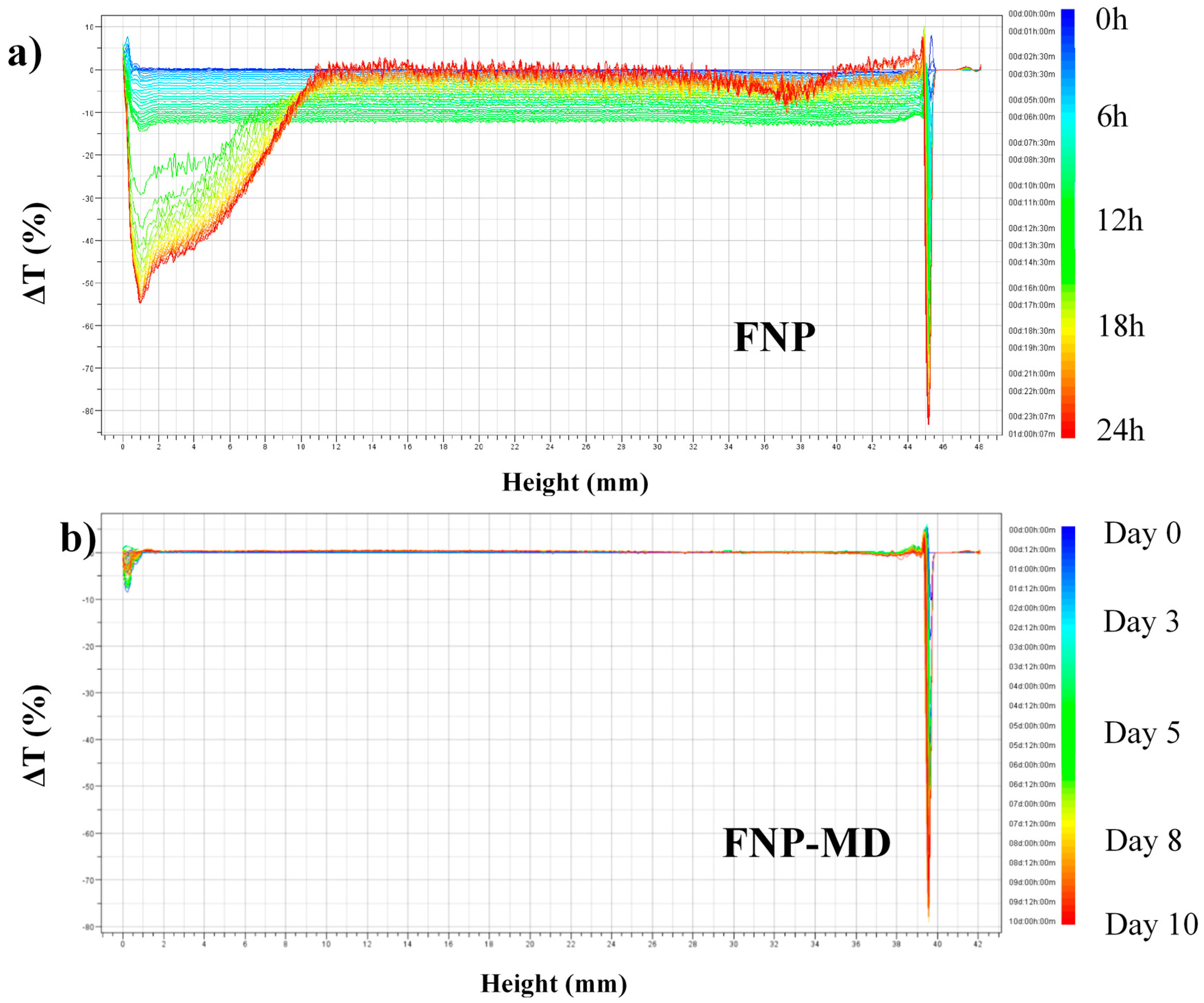
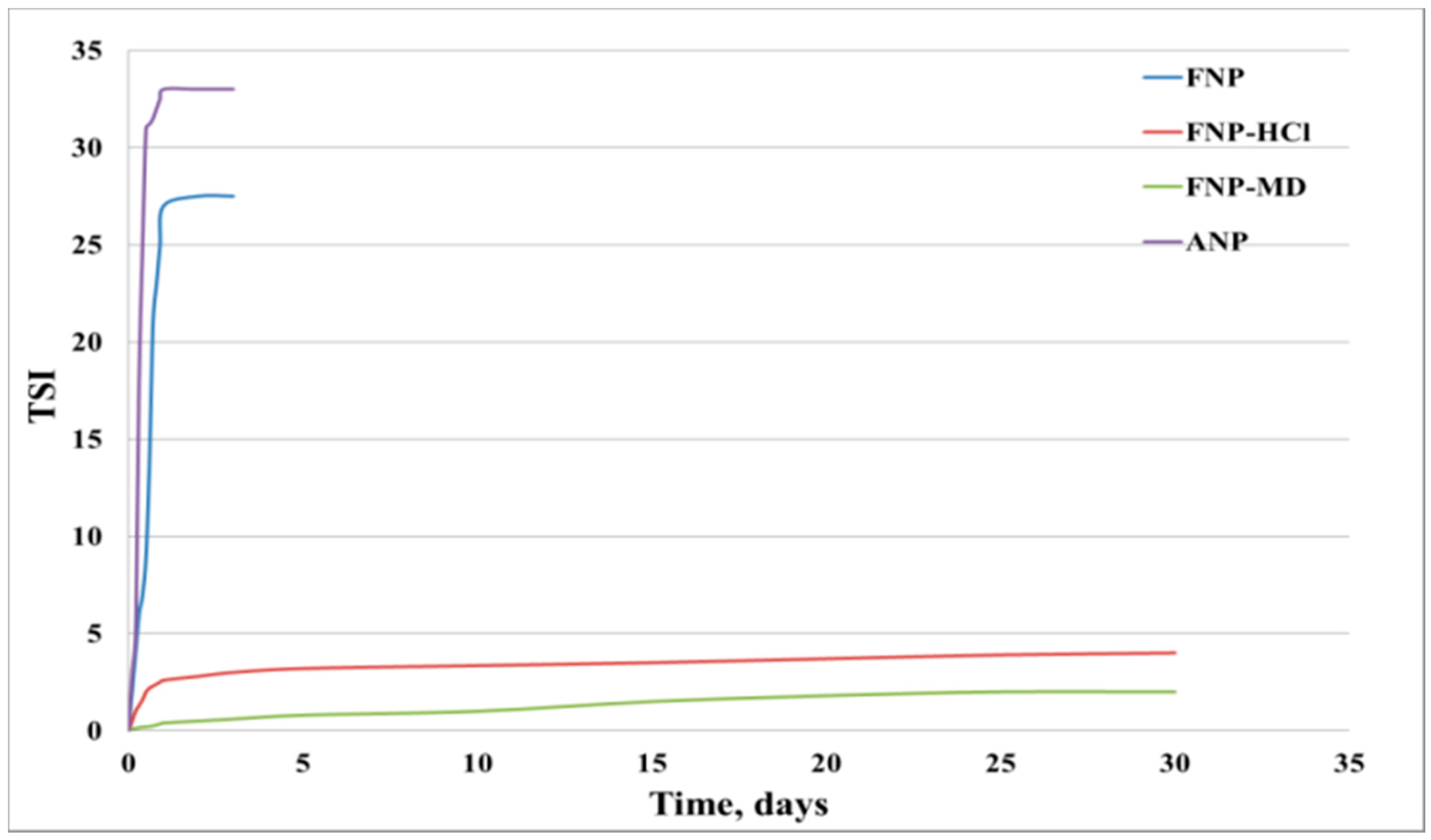
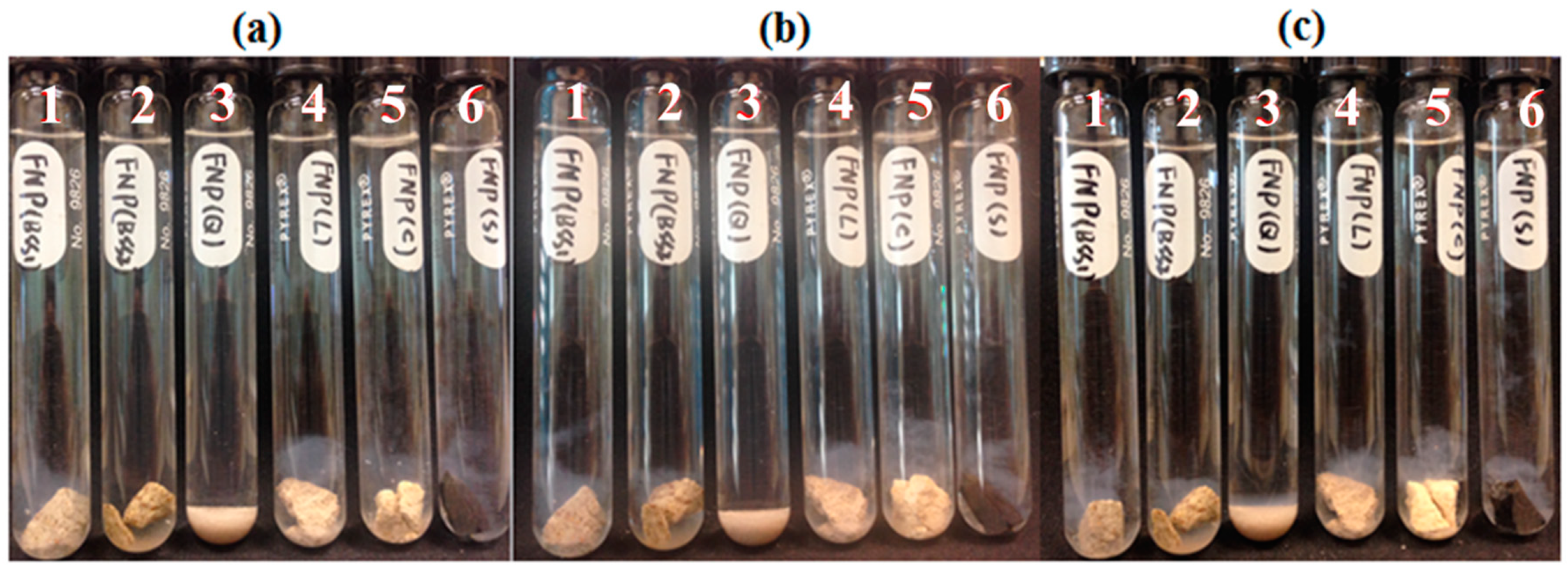


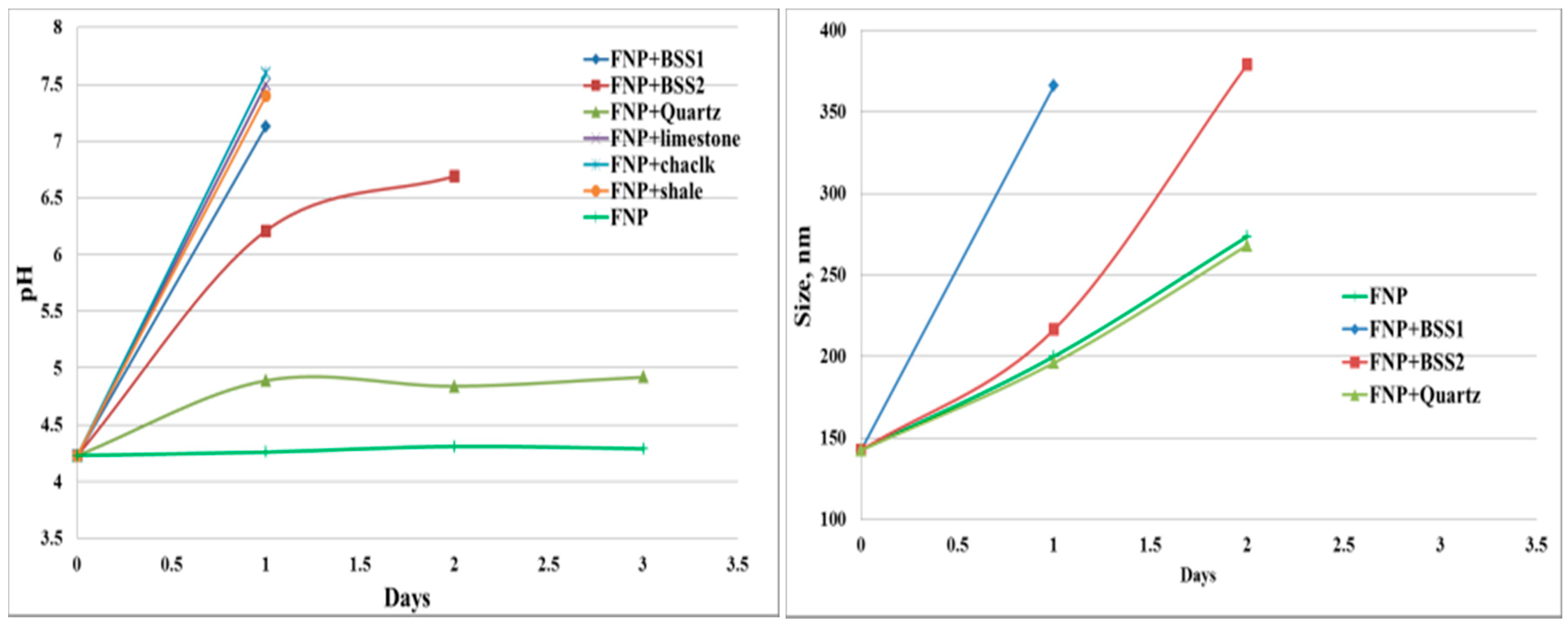
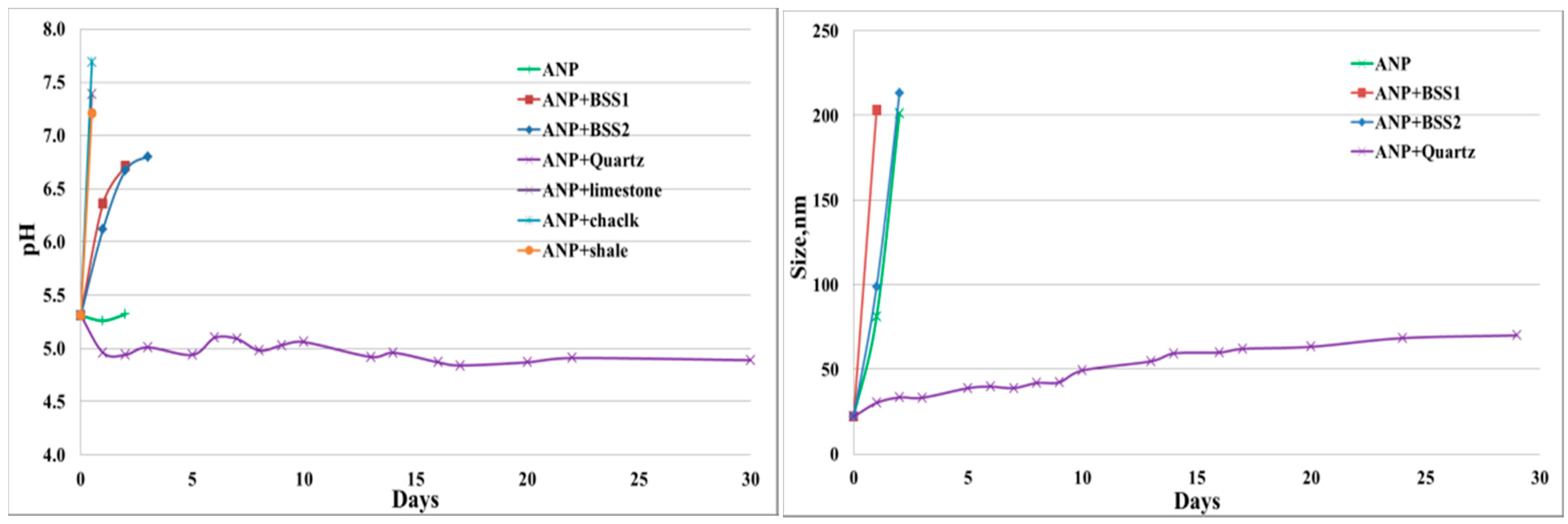
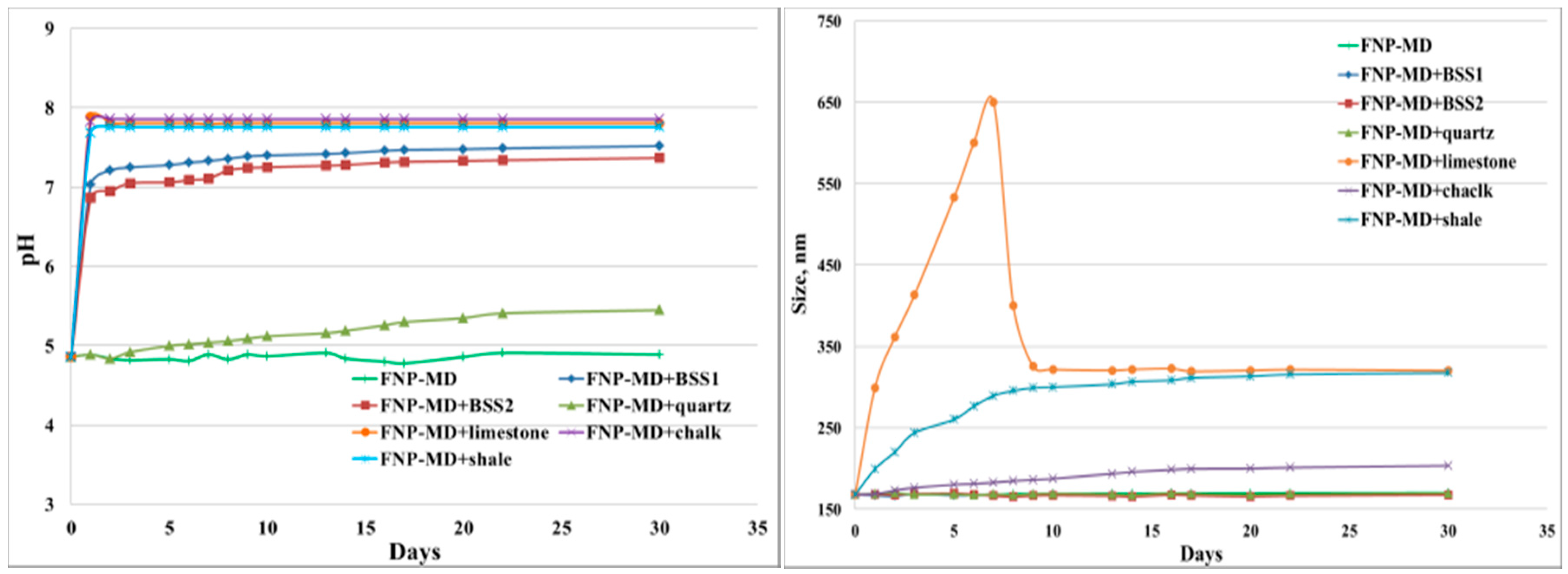
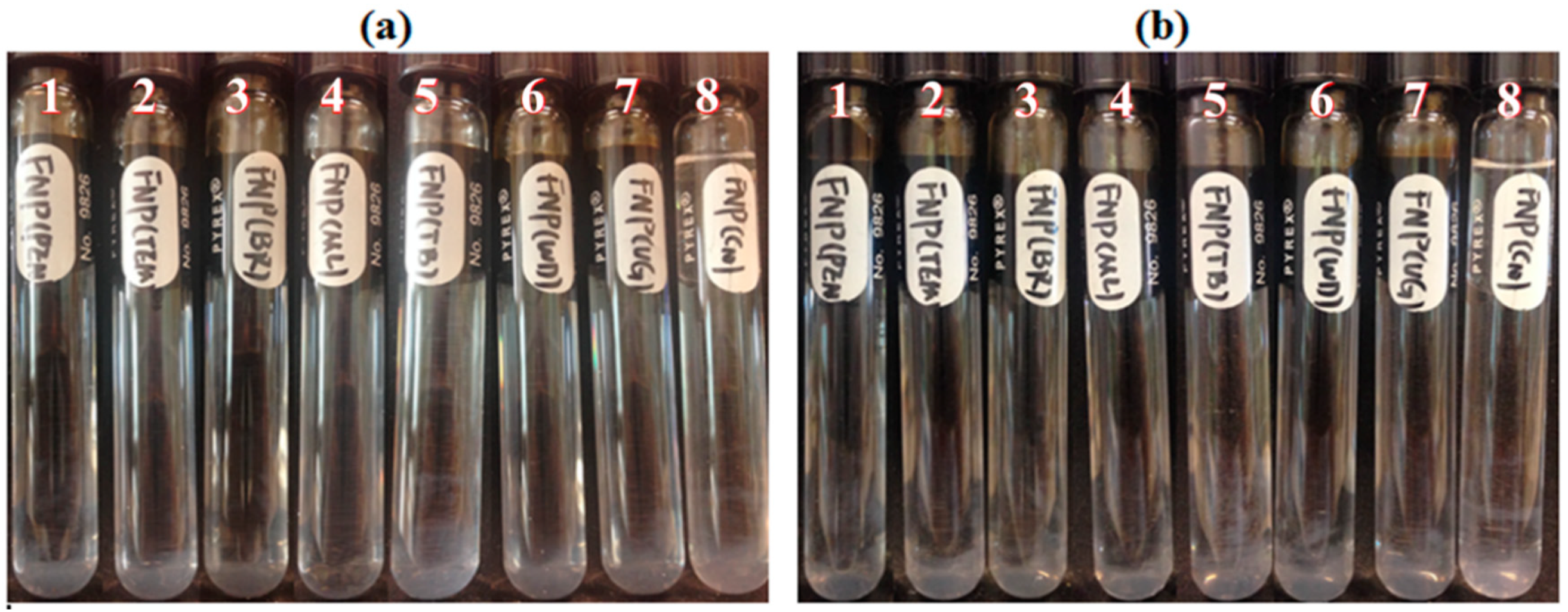
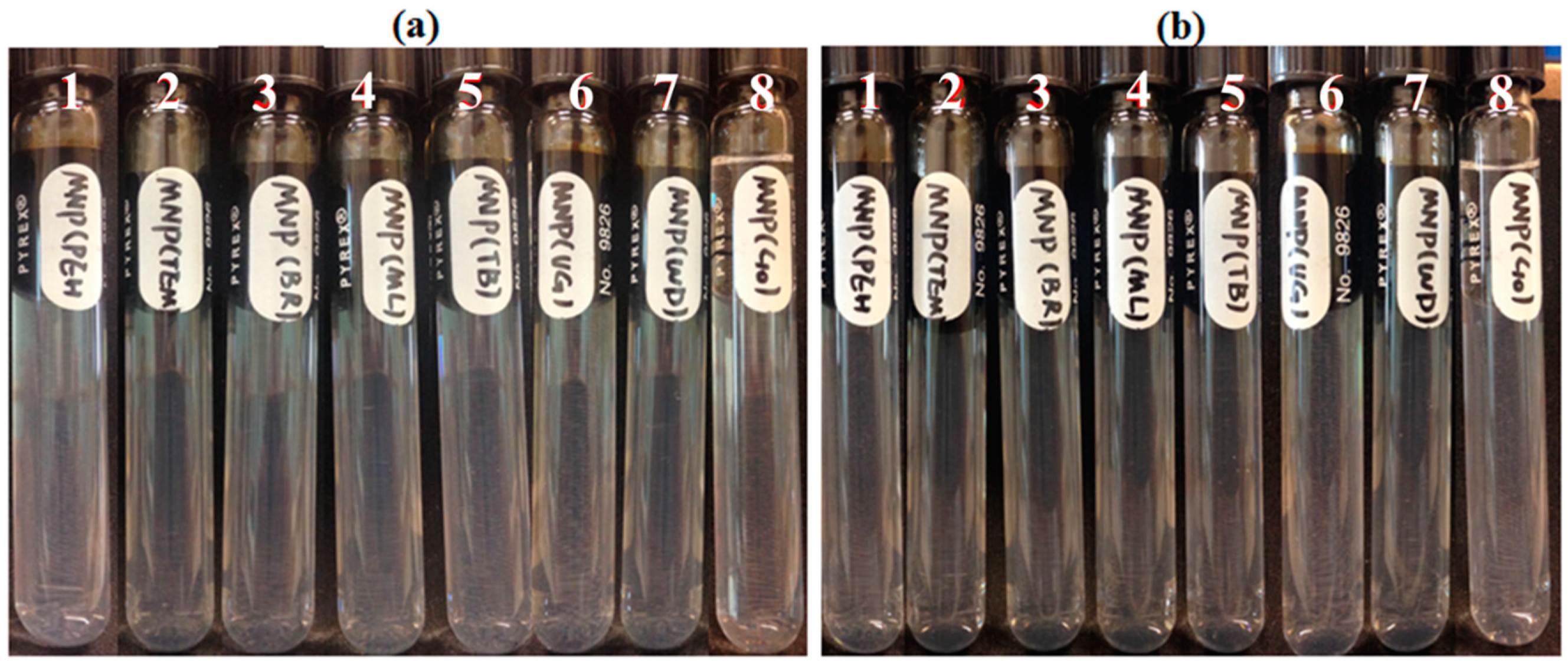
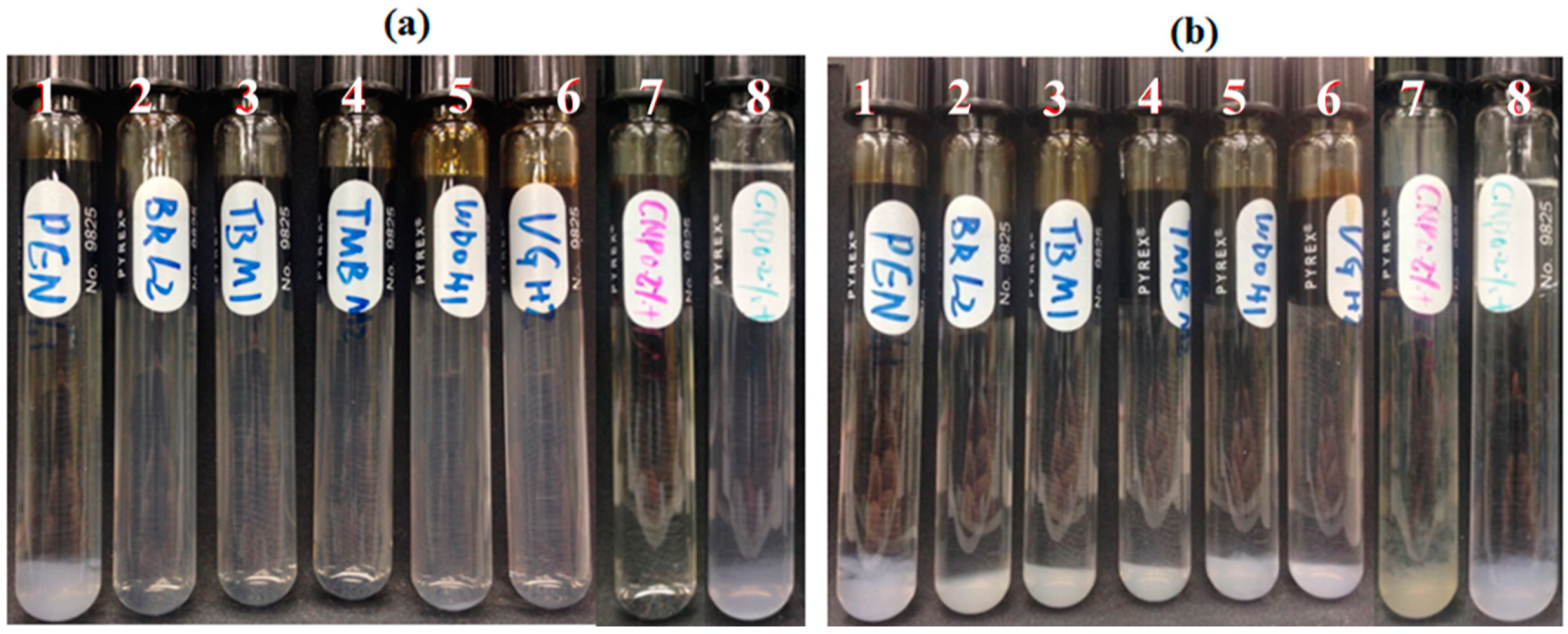
| Salts | Concentration (g/L) | Salts | Concentration (g/L) |
|---|---|---|---|
| CaCl2·2H2O | 1.76 | Na2SO4 | 4.81 |
| MgCl2·6H2O | 11.23 | NaCl | 27.03 |
| % | BSS1 | BSS2 | Chalk | Limestone | Shale |
|---|---|---|---|---|---|
| SiO2 Quartz | 90.87 | 90.31 | -- | 0.69 | 2.84 |
| Na AlSi3O8 Albite | 0.89 | 1.89 | -- | -- | -- |
| KAlSiO8 Sanidine | 0.46 | 0.74 | -- | -- | -- |
| KAL2(Si3Al)O10(OH,F)2 Muscovite | 3.75 | 3.6 | -- | -- | 2.07 |
| Al2SiO5(OH)4 Kaolinite | 1.92 | 2.29 | -- | -- | 1.48 |
| (Mg,Fe)5Al(Si3Al)O10(OH)8 Clinochlore | 0.97 | 0.89 | -- | -- | -- |
| CaMg(CO3)2 Dolomite | 1.13 | 0.28 | -- | -- | 1.89 |
| CaCO3 Calcite | -- | -- | 100 | 99.31 | 89.28 |
| Ca5(PO4)3(OH)2 Apatite | -- | -- | -- | -- | 2.44 |
| CO1 | CO2 | CO3 | CO4 | CO5 | CO6 | CO7 | |
|---|---|---|---|---|---|---|---|
| Saturates | 60.66 | 75.72 | 84.61 | 38.48 | 74.79 | 26.37 | 32.94 |
| Aromatics | 10.52 | 17.43 | 12.76 | 56.13 | 19.79 | 51.90 | 52.26 |
| Resins | 9.68 | 3.85 | 2.32 | 5.33 | 5.06 | 20.76 | 14.80 |
| Asphaltenes | 19.15 | 3.00 | 0.31 | 0.07 | 0.36 | 1.09 | 0.00 |
| Density@70 °C (kg/m3) | 826 | 793 | 786 | 852 | 782 | 926 | 902 |
| Viscosity@70 °C (mPa·s) | 7.66 | 2.47 | 1.90 | 2.43 | 1.51 | 35.61 | 13.06 |
| Sulphur Content (ppm) | 657 | 491 | 655 | 1300 | 574 | 3325 | 1900 |
| Total Acid Number (mg/mg KOH) | 0.064 | 0.475 | 0.103 | 0.260 | 0.239 | 1.720 | 1.702 |
| Days Until Agglomeration Was Observed | ||||
|---|---|---|---|---|
| NPs Conc. (wt. %) | FNP | FNP-MD | FNP-HCl | ANP |
| 0.1 | 1 | -- | -- | 1 |
| 0.2 | 1 | -- | 25 | 8 |
| 0.3 | <1 | -- | 15 | 25 |
| 0.4 | <1 | -- | 12 | -- |
| 0.5 | <1 | -- | 10 | -- |
© 2020 by the authors. Licensee MDPI, Basel, Switzerland. This article is an open access article distributed under the terms and conditions of the Creative Commons Attribution (CC BY) license (http://creativecommons.org/licenses/by/4.0/).
Share and Cite
Li, S.; Ng, Y.H.; Lau, H.C.; Torsæter, O.; Stubbs, L.P. Experimental Investigation of Stability of Silica Nanoparticles at Reservoir Conditions for Enhanced Oil-Recovery Applications. Nanomaterials 2020, 10, 1522. https://doi.org/10.3390/nano10081522
Li S, Ng YH, Lau HC, Torsæter O, Stubbs LP. Experimental Investigation of Stability of Silica Nanoparticles at Reservoir Conditions for Enhanced Oil-Recovery Applications. Nanomaterials. 2020; 10(8):1522. https://doi.org/10.3390/nano10081522
Chicago/Turabian StyleLi, Shidong, Yeap Hung Ng, Hon Chung Lau, Ole Torsæter, and Ludger P. Stubbs. 2020. "Experimental Investigation of Stability of Silica Nanoparticles at Reservoir Conditions for Enhanced Oil-Recovery Applications" Nanomaterials 10, no. 8: 1522. https://doi.org/10.3390/nano10081522
APA StyleLi, S., Ng, Y. H., Lau, H. C., Torsæter, O., & Stubbs, L. P. (2020). Experimental Investigation of Stability of Silica Nanoparticles at Reservoir Conditions for Enhanced Oil-Recovery Applications. Nanomaterials, 10(8), 1522. https://doi.org/10.3390/nano10081522





